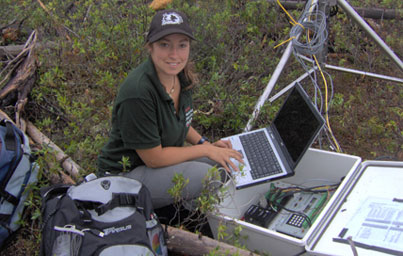MCGILL'S WATERWORLD
Hydro power: How green is it?

Marie-Ève Lemieux
Creating reservoirs in northern Quebec as part of hydroelectric projects is controversial. Nonetheless, most would agree the energy produced in harnessing the flow of water is much "greener" than most other methods, especially those that burn fossil fuels and emit tremendous amounts of greenhouse gases (GHGs).
But Hydro reservoirs emit GHGs too. When forests are flooded, the organic matter in them decomposes and releases gases like C02 and methane. And just how much and at what rate is the subject of a study by a team of McGill researchers. The team is part of a multi-faceted project trying to determine net GHG emissions at Hydro-Québec's Eastmain-1 Reservoir in James Bay.
The McGill team is headed by Dr. Ian Strachan, Associate Professor of Micrometeorology in the Department of Natural Resource Sciences, and Dr. Nigel Roulet, Director of the McGill School of the Environment and a James McGill professor in the Department of Geography. Strachan, MSc candidate Marie-Ève Lemieux, and research professional (and McGill grad) Marie-Claude Bonneville are responsible for the terrestrial aspects of the project; Roulet and PhD candidate Young Il Kim work on modeling. Their work is funded by the Canadian Foundation for Climate and Atmospheric Sciences, and by Hydro-Québec, which supplies the project with equipment, infrastructure and logistics support.
A lot of information on the GHG emissions by reservoirs after they've been created already exists, but most of it relates to tropical forests. Little has been done on northern Boreal reservoirs, where Canadian hydro projects are. Strachan and his team collect data to determine the flux of GHGs like CO2 and methane between the reservoir and the atmosphere, using instruments on a tower installed on an island in the reservoir. Similar towers in the forest and wetlands several kilometres from the reservoir collect control data representing pre-flood conditions. This project got under way in August 2006, as the reservoir was filling. It is scheduled to end sometime in 2010.
"To our knowledge this is the first time this has been done from the initialization of a reservoir, and certainly in a Boreal reservoir," Strachan said. "So it is groundbreaking in that respect."
"We're treating this as a land cover change exercise," Strachan said. "What happens if a you take a Boreal forest ecosystem with wetlands and cover it with water, which is essentially what a reservoir does.
"You might get a flushing of the more decomposable carbon early on. In the first few years you might get a spike. The interesting thing though, is that wetlands are probably a bigger source of methane than a reservoir is, because over time, the reservoir acts more like a lake, which is not as large a source of methane. You may get a lessening of the GHG emissions there, which would offset the CO2 that's coming off the reservoir. So… what's the balance, what is the magnitude of the change, and how long does it take? Those are the issues that we are concerned with."

